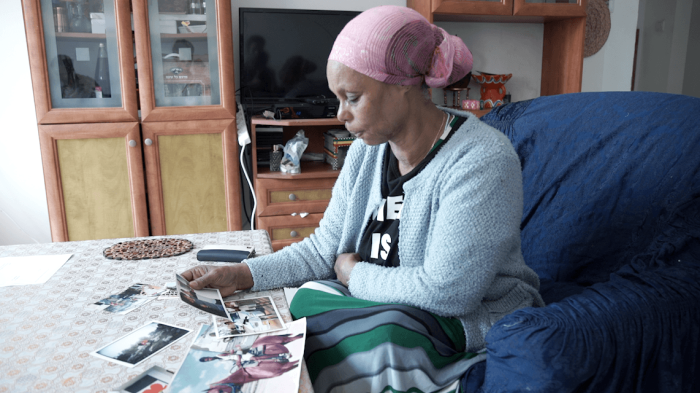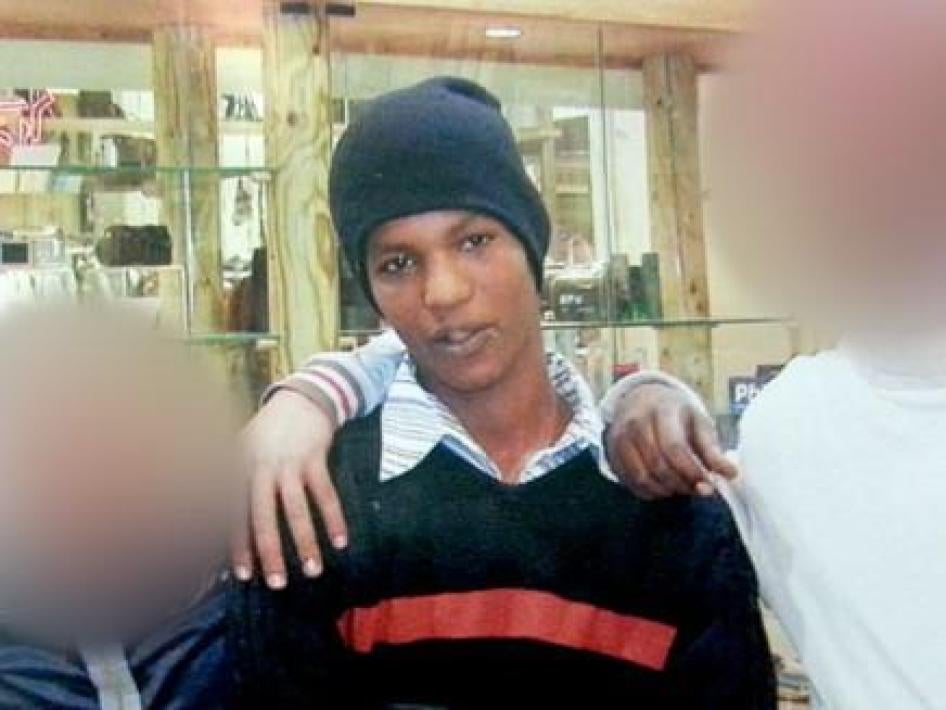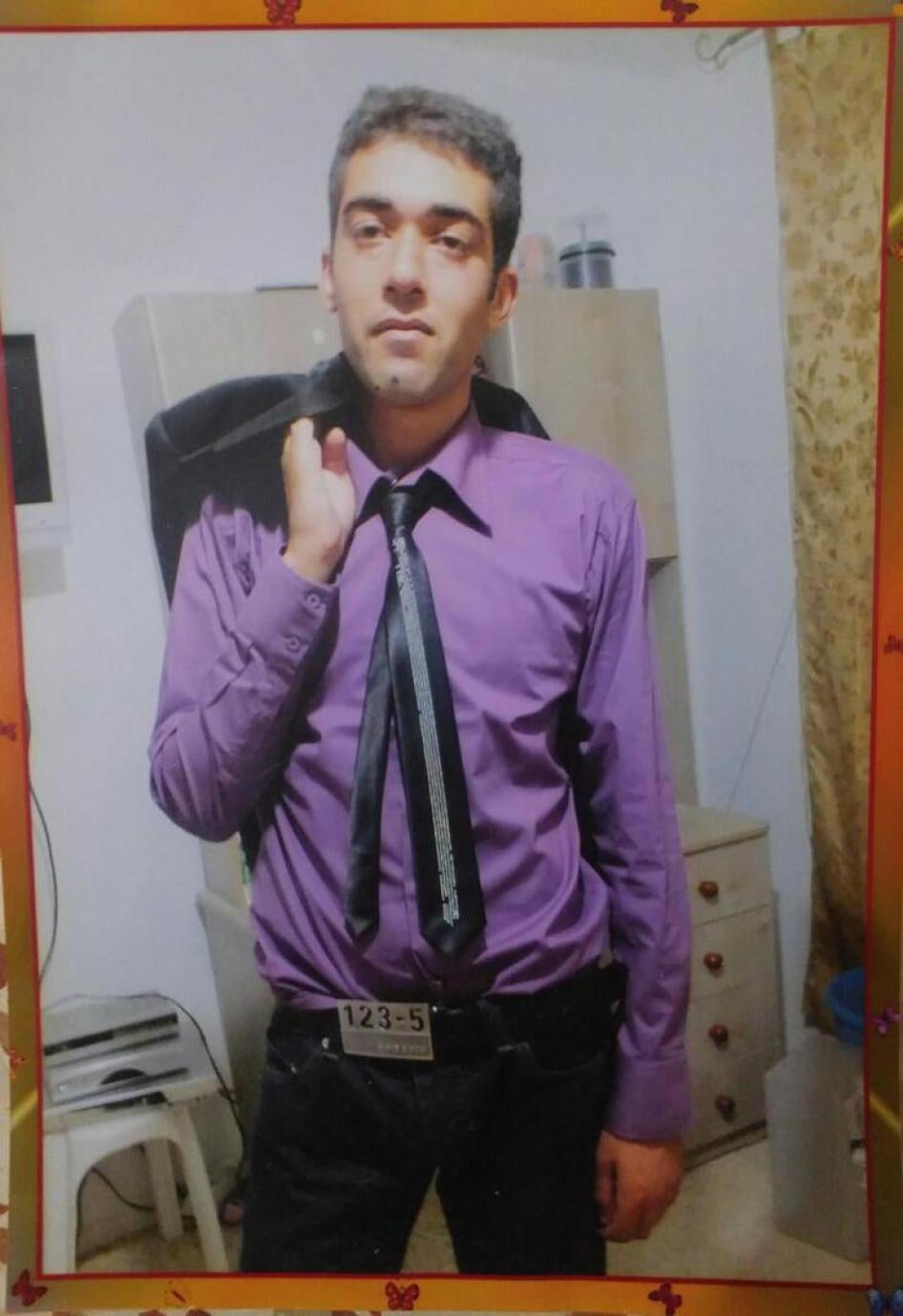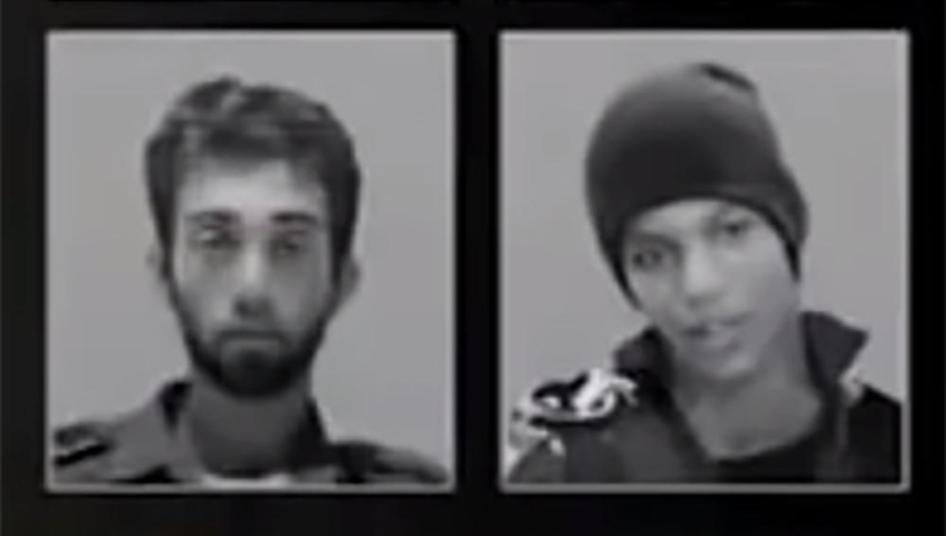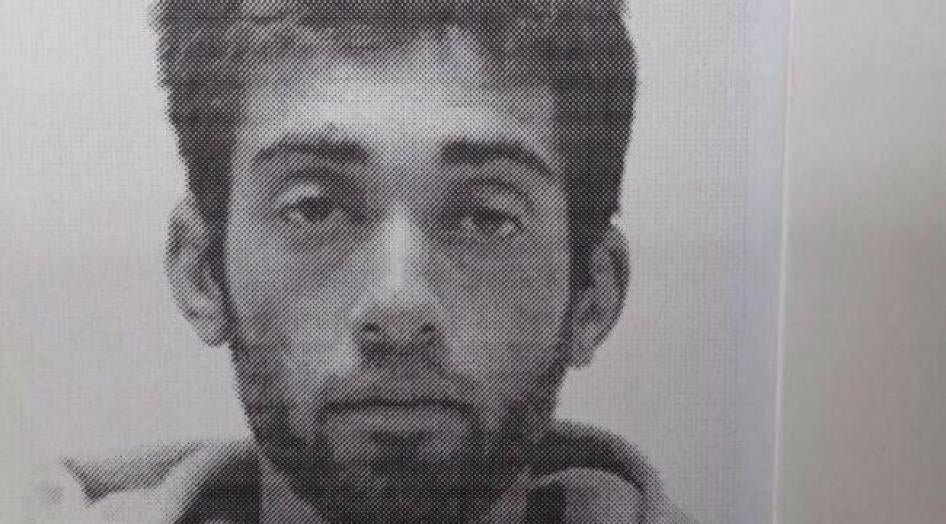Human Rights Watch conducted numerous interviews with the families and friends of the men and with Israeli and Palestinian officials, visited the men’s homes and neighborhoods, and reviewed official medical and military documents.
A third Israeli citizen, 20-year-old Jumaa Abu Ghanima, appears to have crossed from Israel to Gaza in July 2016. His family told Human Rights Watch that they had grown concerned about his mental health and that he entered Gaza while tending his family’s sheep near the border. Human Rights Watch could not, however, independently corroborate their account or confirm his detention or status. The Israeli official indicated that Israeli authorities lack evidence that he is “a missing person held against his will” and the Israel Defense Forces did not respond to a request for information about him. When Human Rights Watch raised his plight with Hamas’s then-Deputy Foreign Minister Ghazi Hamad, he replied, “I don’t know about a third Israeli being held.” Abu Ghanima’s family members told Human Rights Watch that they have not heard from him since his disappearance.
An
April 2016 video issued by the Hamas military wing, the Izz al-Din al-Qassam Brigades, refers to both Mangistu and al-Sayed as soldiers, showing each in photographs, which appear to be photoshopped, in military uniforms, alongside photographs of Oron Shaul and Hadar Goldin, Israel Defense Forces soldiers apparently killed during the 2014 war, whose remains are reported to be in the custody of Hamas authorities. The Israeli authorities have called on Hamas to return Mangistu and al-Sayed – who they maintain were neither soldiers nor had any affiliation to the Israeli government when they entered Gaza – and the bodies of the two soldiers.
The Hamas co-founder, Mahmoud al-Zahar, refused to acknowledge the detention of Mangistu and al-Sayed in a September 2016 meeting with Human Rights Watch, but said that “there are no civilians in Israel” since all serve in the army, and that “Israelis who enter Gaza are spies.”
The Human Rights Watch research cast strong doubt on these claims. Documents Human Rights Watch reviewed indicate that an Israeli Defense Forces medical committee found Mangistu “
unfit for [military] service” in March 2013 and exempted him from mandatory conscription. They also indicate that al-Sayed volunteered for military services in August 2008, but was discharged less than three months later after the military determined him “
incompatible for service,” and is not part of the reserve forces.
In interviews, family and friends of both men said their mental health conditions deteriorated in the years before their disappearance. Israeli Health Ministry documents show that Mangistu spent 19 days in psychiatric hospitalization in January 2013 – 12 days at Beersheva Hospital on a voluntary basis and seven on an involuntary basis – though his specific diagnosis is edited out of the documents released to his family.
Medical reports also reveal that doctors diagnosed al-Sayed with schizophrenia and “personality disorder,” among other conditions, and had him institutionalized many times. A 2013 discharge from a Beersheva Hospital describes him as a “recurring patient” who is “known to psychiatric services for several years,” stating that he fled the facility after a prior hospitalization only to be apprehended near the Gaza border and confined for a “lengthy period of time” in a mental health clinic in northern Israel.
Both Mangistu and al-Sayed had also previously gone missing – Mangistu to northern Israel on two or three occasions, his brother Ilan Mangistu said, and al-Sayed to the West Bank at least 15 times, Jordan twice, and Gaza twice, his father said. An Israeli official with knowledge of the cases said that Israeli records show that al-Sayed entered Gaza and Jordan on multiple occasions.
News reports from February 2010 indicate
a man fitting al-Sayed’s profile with a mental health condition crossed into Gaza –
one identifies him by name.
In an
April 15, 2017 speech, the Hamas leader, Khaled Meshal, declared that “any information about the Israeli captives would carry a price.” Hamas officials in Gaza have stated, including to Human Rights Watch in September 2016, that they would divulge nothing about the missing Israelis until Israel releases the 54 Hamas members whom Israel had re-arrested in the West Bank in June 2014, after freeing them as part of the deal to release the former prisoner Gilad Shalit three years earlier.
Prime Minister Netanyahu said at the time that the re-arrests, which came in response to the abduction several days prior of
three Israeli teenagers in the West Bank, “sent an important message” to Hamas, who he blamed for the abductions. The
teenagers were later found dead.
In light of indications that Mangistu, al-Sayed, and possibly Abu Ghanima have at some point been in Hamas custody, Hamas officials should officially and unconditionally disclose whether each of the men is, or was, in its custody and, if no longer in its custody, whether Hamas has information about his present whereabouts. Revealing the identity of people in custody is an unconditional obligation under international law that cannot be contingent on the fulfilment of actions being demanded of another party. Their incommunicado detention, particularly given their mental health conditions, could amount to cruel or inhumane punishment or even torture.
A government’s refusal to officially acknowledge that a person has been detained or to reveal a person’s whereabouts or fate following detention or arrest, thereby placing the detainee outside the protection of the law, amounts to an enforced disappearance under international law. Enforced disappearance violates many of the rights guaranteed under the International Covenant on Civil and Political Rights, which the state of Palestine ratified in 2014, including the requirement to bring detainees promptly before a judge. Enforced disappearances leave detainees exceptionally vulnerable to torture and other abuse.
The 54 Hamas figures whose release from Israeli custody Hamas demands are among the 6,159 “security” inmates Israel holds, the vast majority Palestinian, and including 493 administrative detainees held without charge, according to Israel Prison Service figures from April 4, 2017 obtained by the Israeli nongovernmental group
Hamoked. Human Rights Watch has documented
Israel’s use of the “Unlawful Combatants Law” to hold Palestinians from Gaza without meaningful judicial review and with
excessive restrictions imposed by Israel on family visits to Palestinian prisoners from Gaza.
“Mangistu and al-Sayed, an Ethiopian Jew and Palestinian Bedouin with mental health conditions, come from among the most marginalized communities in Israeli society,” Whitson said. “There is nothing patriotic or heroic in forcibly disappearing them.”
Avera Mangistu
The fourth of ten children, Avraham (“Avera”) Mangistu emigrated to Israel from Ethiopia with his family at age 5, said his brother Ilan Mangistu. The family settled into a modest apartment in a low-income neighborhood in Ashkelon, where Mangistu lived until his disappearance. His mother, Agurnesh, cleans homes for a living, while his father Haili Mangistu has been unemployed for the past decade, Ilan Mangistu said. The parents divorced in 2012 and Mangistu’s father, unable to afford housing, lived with relatives until he received compensation following his son’s disappearance and was able to move into an apartment.
A childhood friend, who requested anonymity, described Mangistu as a “totally normal boy,” who “laughed, sat in restaurants, had friends.” Upon finishing high school, Mangistu worked on and off in recycling and other odd jobs, Ilan Mangistu said.
Ilan Mangistu said that his brother’s mental state declined in 2011 after the death of an elder brother, Masrashau, from complications related to prolonged anorexia. The family had been unable to obtain proper treatment for him. The childhood friend said that Mangistu coped with his grief alone, withdrawing from family and friends, sitting for hours, going on trips by himself, and growing visibly thinner.
Mangistu said he could feel his deceased brother in his hands, Ilan Mangistu said. Unbeknown to the family, he tied a piece of string around a finger in his right hand, cutting off the blood flow and keeping the finger hidden in his pocket so his family wouldn’t see, until family members discovered he had developed severe gangrene. Doctors had to amputate the finger. He quit working, refusing to even collect a stipend from the National Insurance Institute, and spent much of his time wandering the neighborhood and asking people he knew for money.
Hospital records Human Rights Watch reviewed indicate that Mangistu submitted voluntarily to a psychiatric hospitalization in Beersheva Hospital from January 3 to 15, 2013. Ilan Mangistu said that his brother, who had resolutely refused treatment, only agreed that time after he had gone missing and police located him alone on the shore of the Sea of Galilee in Tiberias, nearly 200 kilometers from home. He was released, however, with no apparent improvement, Ilan Mangistu said. Five days later, family members committed Mangistu to an institution for seven days under an “order for urgent involuntary admission.” Mangistu threw away the psychiatric drugs doctors prescribed as soon as he left the hospital, and resumed his wandering, disappearing to other parts of Israel on one or two other occasions.
Mangistu “would bother people, scream, throw things,” his brother said. “It was very painful. His condition worsened. He had suicidal thoughts. ... He could do dangerous things – put his hand in fire and say it doesn’t hurt.”
In March 2013, a medical committee within the Israel Defense Forces found Mangistu “
unfit” and exempted him from compulsory military service, according to documents reviewed by Human Rights Watch.
His childhood friend said that Mangistu’s mental state got “a lot worse” in the year before his disappearance: “He began to hurt himself. You could see the signs of a person who didn’t sleep for a few days. He began to talk about things that weren’t logical.”
At about noon on September 7, 2014, Mangistu asked his mother for money. When she said she had none, he became angry and then left the house without saying anything.
Later that day, Israeli soldiers noticed on camera a man of dark complexion struggling to climb a barbed wire fence on the Gaza-Israel border near the beach, a representative of the Israeli government with knowledge of the cases told Human Rights Watch. When troops arrived, they shouted at the man, who had reached the top of the fence, and shot in the air, but he did not react, the official said.
The man left behind a school bag and, unsure of his motivations, soldiers decided to evaluate its contents before deciding whether to fire on or otherwise engage him, bringing an EOD robot for the task. The bag contained slippers, a towel, a Bible, and books including an accounting book with the name Avera Mangistu on it that allowed soldiers to identify him, Ilan Mangistu said. The identification process took a few hours, by which time Mangistu had entered Gaza, Israeli security cameras near the border showed. The footage showed him passing a fisherman who did not notice him and later conversing with people beside a shack, the Israeli government representative said.
Mangistu has not been heard from since. The Israeli official said that, in response to third-party queries about Mangistu’s disappearance shortly after he went missing, Hamas presented another man, an Eritrean who had barricaded himself in the border facility between Israel and Gaza requesting international asylum.
Agurnesh Mangistu told Human Rights Watch that she misses her son dearly: “I just keep thinking about him and crying all the time. … Sometimes I go out … when I come back at night his memory keeps me up. … I just want my son to come back here so I can see him.”
Hisham al-Sayed
The eldest of eight, Hisham al-Sayed, 29, was born and raised in the Bedouin village of al-Sayed, which was eventually incorporated into the town of al-Hura, in the Negev desert. Al-Sayed finished high school, but performed poorly, said his father Sha’ban al-Sayed. Sha’ban told Human Rights Watch that he tried to involve his son in his construction business, but that he refused to work and remained at home.
Al-Sayed’s mother, Manal, described him as “never content with the life he has at home and always looking at other people and wishing he had what they have.” Sha’ban al-Sayed noted that “if he sees a truck driver, he wants to become one; a doctor, he wants to be one.” Manal said he wanted to get married and have a job. Al-Sayed married, but he and his wife divorced within a week. Al-Sayed had approached his mother one week before his disappearance to express interest in marrying again. But she said he largely would spend his time watching TV, listening to music, and wandering into the homes and shops of neighbors, who would sometimes tease him or kick him out. Many in al-Hura knew of his mental health condition, Sha’ban al-Sayed added. He said they sent him for short-term study programs in Cyprus in 2005 and London in 2010, hoping a change in scenery would help.
A shopkeeper in al-Hura who has known the family for years said that al-Sayed used to wander into his shop every week or two, depicting him as the “kind of person who if he has something in his mind, does it; if he wants to go to a certain place, he just goes to that place.” He added that al-Sayed “shares everything with everyone and doesn’t hide anything.”
Medical records of al-Sayed’s that Human Rights Watch reviewed show a diagnosis that includes loss of hearing, vertigo, and tinnitus in 2007, “personality disorder and emotional unspecified behavioral and emotional disorders” in 2009, “acute psychotic disorder” in 2010, and schizophrenia in 2013. Al-Sayed also spent significant stretches, spanning from days to weeks, in hospitals and psychiatric institutions throughout the country, including by order of courts and doctors. Sha’ban al-Sayed said that his son tried to escape from at least one institution and that “there is a voice in his head that tells him what to do and he can’t control it.”
A late 2013 letter from a mental health center notes that his admission relates to “behavior exhibiting lack of judgment.” It also states that he was admitted “after having been caught jumping off a fence in Tel Aviv in order, he says, to get to Palestinian taxis so they could take him to Jordan,” and that “he wants to go to Jordan or Thailand and live there in order to see Muslims and Jews together.”
Al-Sayed attempted to go on his own to Jordan five times, his father said. On three of those occasions, security personnel or other people stopped him from crossing. On the two occasions, he entered Jordan, police detained him, the second time for ten days roughly a week before his April 2015 disappearance to Gaza. A representative of the Israeli government with knowledge of the cases said that al-Sayed crossed to Jordan twice, but could not confirm that one of the crossings took place in April 2015.
Sha’ban al-Sayed also said that al-Sayed entered the West Bank in at least 15 separate occasions, three times resulting in his detention by Palestinian Preventive Security.
Al-Sayed also crossed into Gaza in 2010 and 2013, Sha’ban al-Sayed told Human Rights Watch. The Israeli officials said that Israeli records show the crossings took place on February 2, 2010, and January 16, 2013.
Reuters,
AFP,
Haaretz, and
YNet, among others, reported on February 3, 2010 that a Bedouin man fitting al-Sayed’s profile with a mental health condition crossed into Gaza the prior day.
Another source identified him by name as Hisham al-Sayed. The Israeli official also said that al-Sayed crossed into Gaza on May 8, 2011, but Sha’ban al-Sayed said he has no knowledge of this.
A 2016 statement from the Israel Defense Forces reviewed by Human Rights Watch indicated that al-Sayed volunteered for military service on August 18, 2008, but was discharged on November 6, 2008 after being found “
incompatible for service.” The letter further notes that he is “not a part of the reserve forces.”
On April 20, 2015, al-Sayed left the house with his mobile phone and ID without saying where he intended to go. The Israeli official told Human Rights Watch that photos captured by Israeli authorities that day show him walking across the Gaza border from the east. When he did not return home several days later, his parents said, they reported him missing and searched for him in places he had disappeared to before, including Jordan.
He has not been heard from since.
In its July 2015 statement acknowledging Mangistu’s detention, Israeli authorities noted that a second man, “a Bedouin resident of the south,” is “also reported missing in Gaza,” but did not reveal his identity. The al-Sayeds went public with their son’s disappearance shortly after his picture appeared in a
video issued by Hamas’s military wing in April 2016. The picture shows him in military uniform, but appears to be a photoshopped version of the same photo used in
media reports the prior year.
The extended al-Sayed family, of Palestinian Muslim Bedouin origin, has longstanding ties to Gaza, including through marriage, and has relatives living there, the father said. He said that his son used to weep watching the news about Gaza and talk often about how beautiful it was.
His mother described the void al-Sayed has left: “I feel that there is something missing at home. Like I lost something. I am always stumbling, and something major has changed in my life. Hisham was our blessing. He’s been there for a long time now. I feel confused and I don’t know what to do.”
Jumaa Abu Ghanima
Jumaa Abu Ghanima, 20, is a Palestinian Bedouin resident of Beer Abu al-Hamaam, a village not recognized by the Israeli government that is located near the village (moshav) of Nevatim in the Negev desert. Abu Ghanima was found to be missing on July 12, 2016, said his family and media reports. He had just completed his courses at the Abu Tlol high school in the nearby Abu Tlol village, but had not yet taken his required examinations. He was not employed.
Ibrahim Abu Ghanima, Jumaa’s father, told Human Rights Watch that his son had gone that day for the first time to tend to sheep the family owned between the town of Nahal Oz and the eastern border with Gaza. Abu Ghanima did not return home that night as planned, and the next day an Israeli soldier called one of his brothers to say that someone, who the army believed to be Abu Ghanima based on his clothing, had crossed into Gaza the previous day. The Israel Security Agency (or Shin Bet) questioned the family over the course of 30 hours, but left without providing them with conclusive information, the father said. He said that the family has not heard from his son or received proof that he is in Gaza or had contact with Israeli or Palestinian authorities about his whereabouts.
In interviews with Human Rights Watch, the father and several of Abu Ghanima’s brothers said they grew concerned about Abu Ghanima’s mental health in the year before his disappearance. They said they took him to see a doctor and a religious leader to address his condition. The relatives did not provide a name or diagnosis for his condition. Abu Ghanima’s brothers said he had difficulty focusing, kept largely to himself, not sharing things even with his family, had no friends, and was not active on social media. They said that his condition would not be apparent to someone who had just met him and that he was not taking medications. They added though that he had not disappeared before or been to Gaza, was not particularly religious or political, and did not take drugs, smoke, or drink alcohol.
A former teacher of his provided a consistent description in an interview with Human Rights Watch, highlighting his inability to concentrate and tendency to keep to himself.
Human Rights Watch could not corroborate this account. The family did not provide documentation of his medical history. Human Rights Watch attempted to interview others in Abu Ghanima’s community, but the family indicated that no one else knew him.
An Israeli official indicated that Israeli authorities lack evidence that he is “a missing person held against his will.” Human Rights Watch wrote to the Israel Defense Forces on March 29, 2017, to inquire about Abu Ghanima’s status and date of entry into Gaza, but has received no response.
Hamas officials have not made reference to Abu Ghanima, either by name or picture, in any public commentary. When Human Rights Watch raised his case with Ghazi Hamad, the Hamas-then-deputy foreign minister, he said, “I don’t know about a third Israeli being held. There were reports that [Abu Ghanima] was wandering near the Gaza border.”
Family members said they had not heard from him since he went missing.
Additional Legal Considerations
Under international law, countries must investigate enforced disappearances, hold anyone responsible to account, and properly compensate victims. The Convention on the Rights of Persons with Disabilities, which the state of Palestine ratified in April 2014, also provides protections for people with psychosocial, or mental health, disabilities, including freedom from cruel and inhuman treatment and equal access to justice, which may include reasonable accommodations that take into account their disability.
If, as seems the case, Mangistu and al-Sayed entered Gaza in conditions unrelated to the international armed conflict between Israel and Hamas, international human rights law would require authorities to detain them solely according to clear domestic law, which would mean either to charge them with a recognizable crime or release them. The same principles would apply to Abu Ghanima if he is in custody.
Whatever the legal basis for detention, the men have the right to humane treatment that takes into consideration their mental health conditions and any reasonable accommodation required while in detention, as well as access to healthcare services including mental health care on the basis of free and informed consent. Detainees also have the right to contact with their families and visits by the International Committee of the Red Cross. In case of criminal prosecution, information regarding any accusation should be provided in language they can understand, and the procedural accommodations, such as support persons to facilitate communication, should be available based on their needs and preferences.
Methodology
Human Rights Watch has conducted several interviews with members of the Mangistu, al-Sayed and Abu Ghanima families since 2016, visiting each in their homes. Israel’s Permanent Mission to the United Nations in Geneva facilitated the initial meeting with the Mangistu family, in March 2016. Human Rights Watch reviewed extensive documentary evidence on Mangistu and al-Sayed, including medical records and military service paperwork, which the Mangistu and al-Sayed families gave Human Rights Watch permission to share, and spoke to people who knew the men from their communities.
After obtaining permission from Israeli authorities to enter Gaza in September 2016, for the first time since 2008, Human Rights Watch raised the cases with senior Hamas political official Mahmoud al-Zahar, and with officials of the Gaza authority, then-Deputy Foreign Minister Ghazi Hamad, then-Deputy Justice Minister Omar al-Borsh, then-General Inspector of the Interior Ministry Mohammad Lafi, and then-Deputy Interior Minister Kamal Ahmed Abu Mady. It also interviewed a representative of the Israeli government with knowledge of the Mangistu and al-Sayed cases and viewed technical documentation which Israeli authorities say shows Mangistu’s crossing.
Human Rights Watch sought, but was unable to obtain, information about Abu Ghanima beyond what his family and a former high school teacher told us. His family had no documentation on his health condition and, when asked for contacts of other people, said no one else in the community knew him. Human Rights Watch sought official comment from the Israel Defense Forces on Abu Ghanima’s status and date of entry into Gaza, but has received no response.
